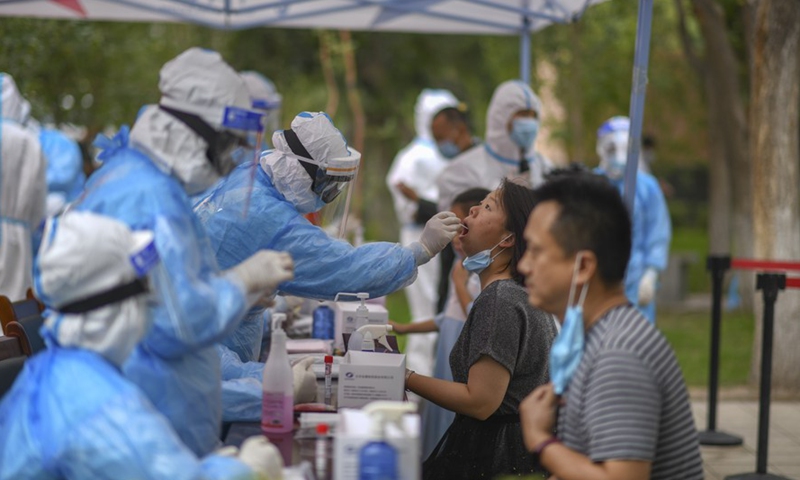Urumqi starts new round of nucleic acid tests in key areas before adjusting prevention measures
By Liu Caiyu and Liu Xin Source: Global Times Published: 2020/8/26 21:38:27

Medical workers collect swab samples for residents at Tianshan District in Urumqi, northwest China's Xinjiang Uygur Autonomous Region, July 20, 2020. Urumqi is carrying out free nucleic acid tests for all residents and people who are visiting the city, in a bid to screen for novel coronavirus infections and reduce the risk of the epidemic spread.Photo:Xinhua
Urumqi in Northwest China’s Xinjiang Uygur Autonomous Region on Wednesday started to conduct a new round of nucleic acid tests among key communities and later adjust its current prevention measures for COVID-19 to gradually restore normality.
The announcement was made at a press conference organized by the information office of the Xinjiang regional government. The region has reported zero new infections for 10 consecutive days.
As the battle against the epidemic enters its last stage, a new round of nucleic acid tests will assure the public and government in a bid to gradually ease restrictions among communities and pave the way for promoting the city to return to normality, Zhang Yuexin, a medical expert who is part of the Xinjiang anti-epidemic group, told the Global Times on Wednesday.
Some key communities in Urumqi had undergone nucleic acid tests five to six times to screen out silent carriers, but for this new round of tests, it aims to ease communities’ lockdowns, allowing more residents to walk around within the communities, Zhang said.
Starting from Sunday, Urumqi has allowed residents in some communities where there are no COVID-19 patients to venture downstairs for fresh air. But the easing restrictions have been carried out in a very cautious way – a pass is required before a resident can go outside, volunteers were also stationed within the community in the case of crowds gathering or people not wearing masks, with daily outing durations limited to one or two hours.
This round of new tests may not lead to a total lift of lockdowns, Zhang said, explaining that scientifically speaking, Urumqi could consider to lift its lockdown after no new infections were found in two incubation periods – that is 28 days. As of Wednesday, the city reported zero cases for 10 consecutive days.
As the source of infections remain unknown for this wave of clustered infections, Xinjiang is borrowing experiences from other cities in fighting against the epidemic, including remaining vigilant over the viral spread via transportation or cold-chain products, Zhang said.
As of Wednesday, Xinjiang has hospitalized 124 confirmed patients, including 4 severely ill, 44 silent carriers and 3,024 under medical observation.
With the help of the national medical team, Zhang said COVID-19 patients in Urumqi show a high cure rate. The cure rate among severely ill patients is higher than in Wuhan when an outbreak took place there, the medical expert said.
Aside from Uqumqi, residents in other parts in Xinjiang reached by the Global Times said that low-risk areas are gradually returning back to normal life. A volunteer surnamed Pa in Ili Prefecture told the Global Times that many residential communities are open and residents can go outside to buy daily necessities by themselves.
Some residents in southern Xinjiang also confirmed that life is gradually returning to normal in recent days.
As the whole of society calls for the restoration of normal social and economic development, the Xinjiang region is arranging work in advance and pushing for coronavirus prevention measures.
According to a report from local news outlet ts.cn, the main leaders of Xinjiang held a meeting on Tuesday, stressing to take targeted prevention measures for key areas and groups, and pushing for economic and social management to return to normal.
Posted in: SOCIETY